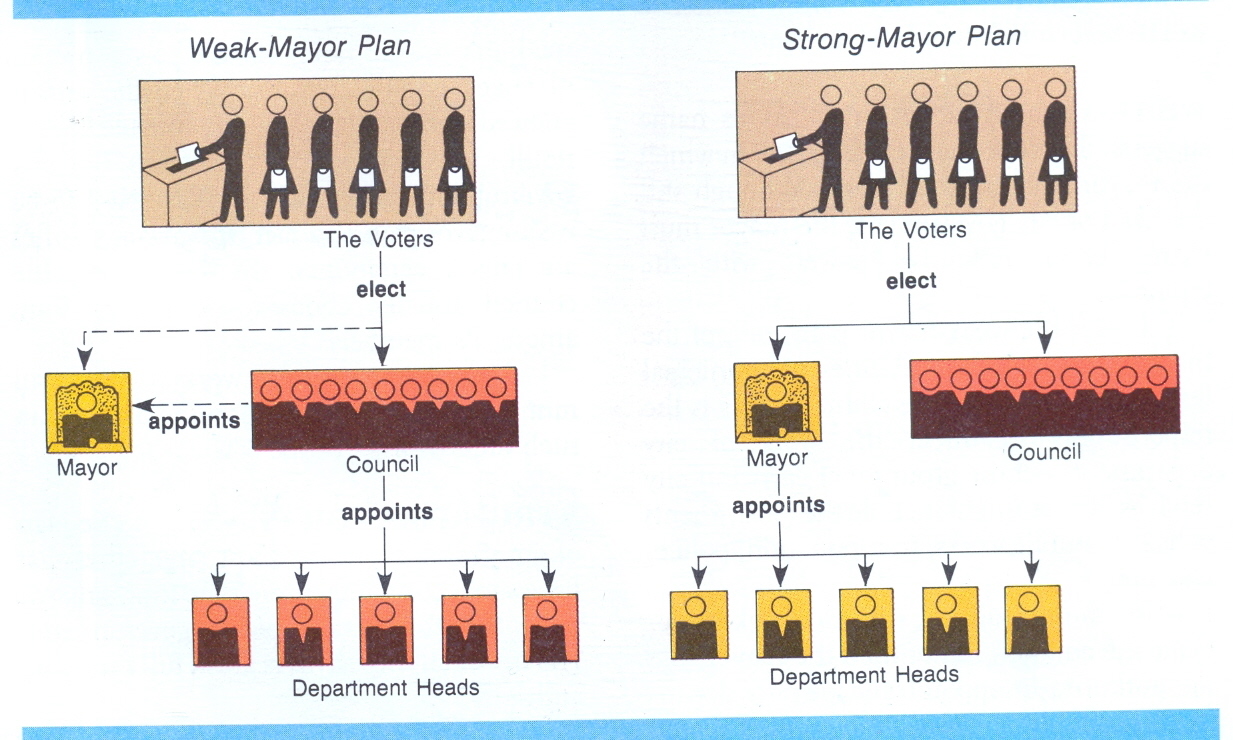
- •Unit III local governments in the usa
- •Task 2. Translate from Russian into English:
- •Mayor-council government
- •Council-manager government
- •Commission government
- •Supplementary reading
- •Improving Citizen Services and Access to Government
- •Major Urban Centers
- •Smaller Urban Centers
- •Part 2 Suburbs
- •Southerners and Easterners Give States Highest Ratings
- •Bottom Line
Mayor-council government
|
COUNCIL-MANAGER GOVERNMENT
The mayor-council form of government has been the most widely used over the years. Many cities today, however, are turning to another kind of municipal government—the council-manager form. Under this plan, citizens elect a council of several members. The council is chosen to carry out legislative duties. The council then hires a manager to take care of the day-to-day business of the city.
The council-manager government began as part of a reform movement in the early 1900's. It was first tried in the city of Staunton, Virginia, in 1908. In many cases, it was adopted in areas that needed quick action to solve pressing problems. The people of Dayton, Ohio, for example, turned to the council-manager form after a flood.
In most council-manager governments today, the manager controls the various city departments. He or she appoints and dismisses department heads and other leaders. The manager also prepares the budget and may advise the council on important matters. The manager thus carries out many executive duties.
Keep in mind, however, that the manager is hired to conduct city business as directed by the council. It is the council that sets basic policy. If the council is not pleased with the manager's work, he or she can be fired at any time.
In some cities, the council-manager government also includes a mayor. The mayor may be elected by the people or chosen by the council. Under this plan, however, the mayor has few powers.
Today, more than one third of all cities, including Dallas and Fort Worth, Texas, and Cincinnati, Ohio, use the council-manager form.
Figure 4
Council-manager government
|
COMMISSION GOVERNMENT
A third form of government used in some municipalities today is the commission form. It is, however, the least common form of municipal government.
In the commission form, citizens elect from three to seven city leaders. These leaders serve on a board of commissioners. Often, the commissioners are chosen from the city at large, rather than from separate city wards.
The board of commissioners handles both executive and legislative responsibilities. Each commissioner carries out executive duties by heading one or more of the city departments. One commissioner, for example, may direct public safety. Another might be in charge of city finances. Acting together, the board also serves as the city's legislature with the power to pass laws.
In most municipalities that have a commission form of government, the citizens do not elect a mayor. Often, the board chooses one of its members to act as a chairperson. This person sometimes is known as the mayor, but the title is largely ceremonial. In the few cases in which a mayor is chosen by the people, the powers of the office are quite limited.
The commission form of government first developed as the result of a local disaster. In 1900, the city of Galveston, Texas, was struck by a devastating hurricane and tidal wave. The municipal government, a weak-mayor plan, proved unable to deal with the emergency. Within a year, Galveston voters chose a board of five commissioners to lead the city. The commission government was the result.
By 1915, almost 500 cities had adopted this plan. Since that time, however, this number has gradually decreased. Many believe the decline is due, in part, to a lack of clear leadership. With each commissioner pursuing the interests of a certain department, it often is difficult to coordinate city goals and policies. Even Galveston eventually abandoned this plan in favor of the council-manager form. Today, less than 200 municipalities across the country use the commission form of government.
Figure 5


